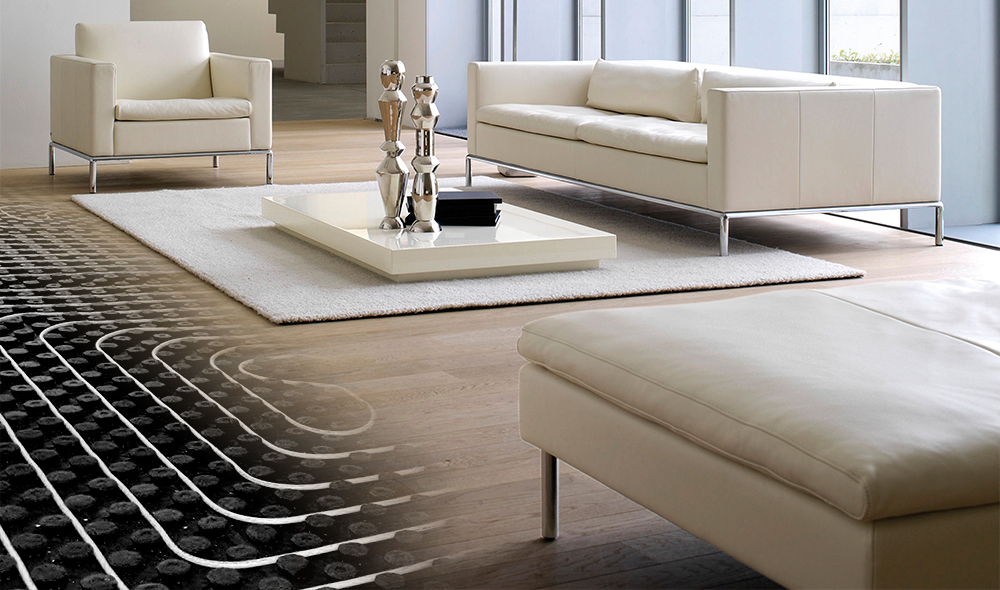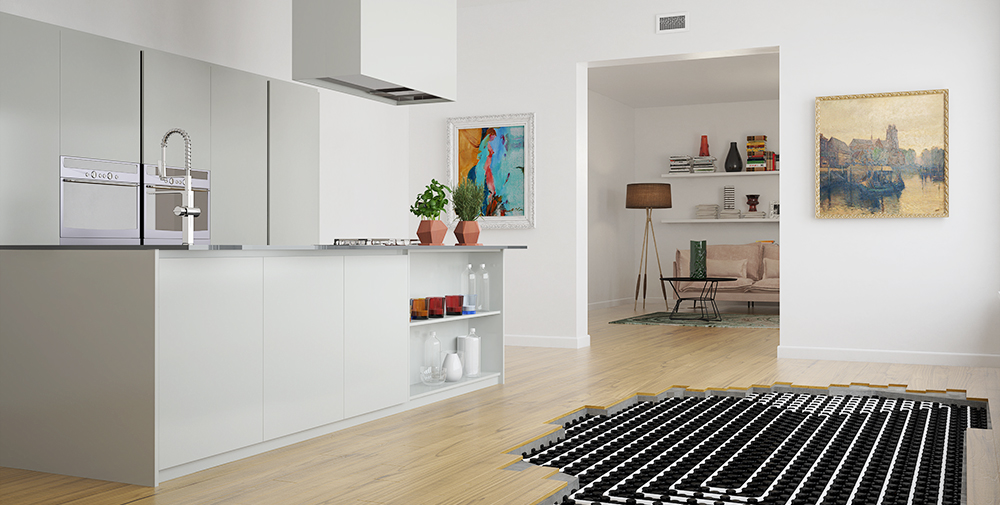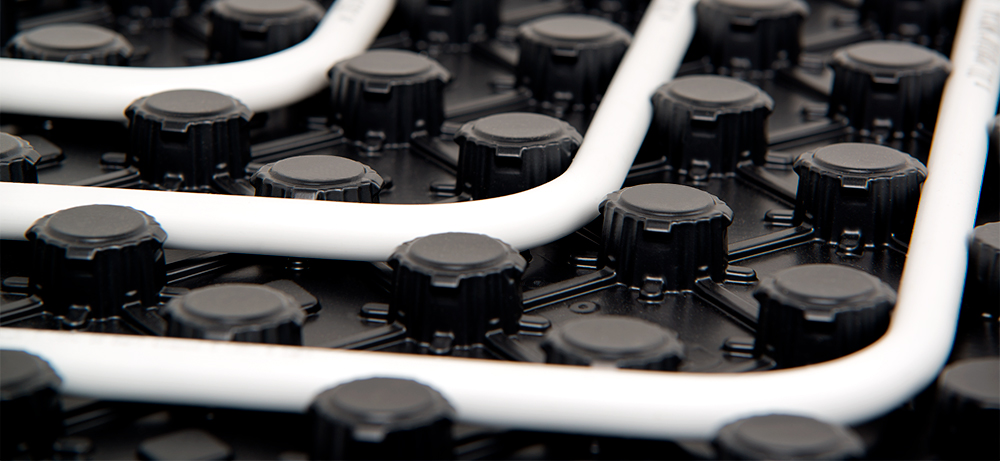Underfloor heating is a heating system that uses the floor surface to distribute heat evenly throughout a room. Unlike traditional radiators, there are no noticeable temperature differences between different areas of the room.
Heat is transmitted by radiation, i.e. electromagnetic waves that heat people and objects directly, creating natural, uniform comfort.
Why choose a floor heating system?
There are many extremely valid reasons, which we can summarise as follows:
Thermal comfort
Thanks to the uniform distribution of heat from the floor upwards, thermal stratification is avoided. The result is a comfortable and constant environment, without “cold” or “too hot” areas.
Aesthetics and design freedom
As there are no visible radiators, the design of the rooms is cleaner. The absence of architectural constraints allows you to make the most of every square metre.
Energy savings and sustainability
The underfloor system operates at a low temperature (approximately 30-40 °C), allowing for energy savings of up to 25% compared to traditional systems. It also combines perfectly with renewable energy sources such as heat pumps and solar thermal energy.

How does an underfloor system work?
Hot water circulates in pipes laid under the floor, heating the screed and spreading the heat by radiation, with natural and constant distribution.
Differences from traditional systems
With radiator systems, heating the air creates convective currents that lead to temperature fluctuations. Underfloor heating, on the other hand, distributes heat evenly and reduces the circulation of dust and allergens, improving air quality.
The underfloor heating system consists of a few simple components:
The pipes
These play a crucial role in heat transmission, especially when it comes to multilayer pipes (made of polyethylene and aluminium). They guarantee a long system life, an insurmountable barrier to oxygen that eliminates the risk of algae growth and greater thermal efficiency compared to plastic pipes.
The screed
This incorporates the pipes and distributes the heat. It can have high or low thermal inertia depending on its thickness, which affects the response speed of the system.
Using a thicker screed increases thermal inertia, meaning that the system takes longer to heat up but maintains the temperature for longer. This is ideal for those who spend a lot of time indoors.
With a thinner screed, thermal inertia is reduced and the system responds more quickly to temperature changes. Perfect for modern buildings or renovations, where you want to achieve an extremely responsive system or cope with reduced thicknesses that are otherwise not compatible with radiant technology.
The insulating panel
This prevents heat loss downwards and facilitates installation. Various models are available, smooth or embossed, specific to each architectural scenario.
The manifold
This distributes the water to the various circuits and balances the system. It is a fundamental element for the correct functioning and regulation of the system.

We can also make a simple distinction between the different types of underfloor heating systems.
Where can a floor system be installed?
A floor system is ideal for designing efficient spaces right from the foundations. It allows integration with all modern systems and is often synonymous with energy optimisation.
Today, there are low-thickness solutions that allow radiant systems to be installed even in existing buildings without invasive demolition.
There is also a wide range of flooring options to choose from, whatever your preference for the final floor finish.
Underfloor heating is now a choice that leaves little room for doubt: suitable for any type of building and any type of flooring, it guarantees a level of comfort and energy efficiency that is simply unmatched by a traditional radiator heating system.
Average consumption compared to other systems
Energy savings can be between 15% and 25% compared to traditional systems. This depends on variables such as the insulation of the building and the energy source used.
The quality of the insulation, the flow temperature, the regulation and the type of generator have a strong influence on consumption. The use of smart thermostats can further improve efficiency.
Of course, the energy source that will power the system is also crucial. In this case, there are several “green” options to choose from:
Heat pumps
Perfect for working at low temperatures. Combining them with underfloor heating is one of the most efficient and popular options.
Solar panels
Solar thermal panels can provide hot water to power the system. Photovoltaic systems can also help reduce energy costs.

How long does an underfloor heating system last and how is it maintained?
A well-designed system can last over 30-35 years. The pipes are almost always the determining factor in the longevity of the system: high-quality pipes are designed to withstand the test of time without deteriorating.
Maintenance is minimal. Periodic checks of the collector, pressure and heat generator are recommended. As there are no fans or filters, the air quality is better and allergies are reduced.
Myths to dispel
Let's also look at some common misconceptions that, especially in the past, have contributed to confusion about the possibility of installing an underfloor heating system.
‘It doesn't heat enough’
False. Heat is distributed more efficiently and naturally, improving the perception of comfort even at lower temperatures.
‘It takes too long to come on’
It depends on the type. Low-inertia systems are extremely responsive and also suitable for intermittent use.
‘It's not suitable for parquet flooring’
It is perfectly compatible, you just need to choose the right wood and installation techniques.
 Italiano
Italiano
 English
English
 Deutsch
Deutsch
 Français
Français
 Español
Español
 Greek
Greek